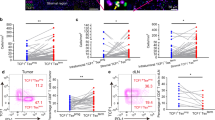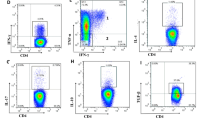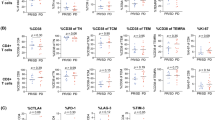Abstract
Background
Although regulatory T cells (Tregs) are thought to play an important role in immune suppression, their clinical significance in head and neck squamous cell carcinoma (HNSCC) is unclear. A recent study reported Tregs could be divided into functional subsets based on the expression of CD45RA and Foxp3.
Method
The frequency of circulating Treg subsets was analyzed in patients with HNSCC and compared with the frequency in patients with benign tumors. The association of Treg subsets with the frequency of lymphocyte subsets, status of progression, clinical course, and prognosis were also examined.
Results
The frequency of CD4+Foxp3+ Tregs was comparable between HNSCC patients and age-matched benign tumor patients; however, CD45RA−Foxp3high Tregs were significantly increased in HNSCC patients, in particular those with advanced stage tumors. The high frequency of CD45RA−Foxp3high Tregs correlated with a poor prognosis and the low frequency of CD45RA−Foxp3high Tregs before treatment showed a better clinical outcome, even in patients with advanced stage tumors. CD45RA−Foxp3high Treg numbers were decreased after intensive treatments; however, Treg numbers recovered in the early stages of recurrent cases, even before the clinical manifestation.
Conclusion
CD45RA−Foxp3high Tregs are associated with the clinical course of HNSCC and might be a new target for treatment and an early marker of tumor recurrence in HNSCC patients.




Similar content being viewed by others
Abbreviations
- CDDP:
-
Cisplatin
- CCRT:
-
Combined chemotherapy and radiotherapy
- CFSE:
-
Carboxyfluorescein diacetate succinimidyl ester
- CR:
-
Complete remission
- CTLA-4:
-
Cytotoxic T-lymphocyte-associated protein 4
- HNSCC:
-
Head and neck squamous cell carcinoma
- MDSCs:
-
Myeloid derived suppressor cells
- PBMCs:
-
Peripheral blood mononuclear cells
- RT:
-
Radiation therapy
- Tregs:
-
Regulatory T cells
References
Howell GM, Grandis JR (2005) Molecular mediators of metastasis in head and neck squamous cell carcinoma. Head Neck 27:710–717. doi:10.1002/hed.20222
Weed DT, Vella JL, Reis IM et al (2015) Tadalafil reduces myeloid-derived suppressor cells and regulatory T cells and promotes tumor immunity in patients with head and neck squamous cell carcinoma. Clin Cancer Res 21:39–48. doi:10.1158/1078-0432.CCR-14-1711
Albers AE, Strauss L, Liao T, Hoffmann TK, Kaufmann AM (2010) T cell-tumor interaction directs the development of immunotherapies in head and neck cancer. Clin Dev Immunol 2010:236378. doi:10.1155/2010/236378
Duray A, Demoulin S, Hubert P, Delvenne P, Saussez S (2010) Immune suppression in head and neck cancers: a review. Clin Dev Immunol. 2010:701657. doi:10.1155/2010/701657
Freiser ME, Serafini P, Weed DT (2013) The immune system and head and neck squamous cell carcinoma: from carcinogenesis to new therapeutic opportunities. Immunol Res 57:52–69. doi:10.1007/s12026-013-8462-3
Horinaka A, Sakurai D, Ihara F, Makita Y, Kunii N, Motohashi S, Nakayama T, Okamoto Y (2016) Invariant NKT cells are resistant to circulating CD15+ myeloid-derived suppressor cells in patients with head and neck cancer. Cancer Sci. 107:207–216. doi:10.1111/cas.12866
Parker KH, Beury DW, Ostrand-Rosenberg S (2015) Myeloid-derived suppressor cells: critical cells driving immune suppression in the tumor microenvironment. Adv Cancer Res 128:95–139. doi:10.1016/bs.acr.2015.04.002
Takeuchi Y, Nishikawa H (2016) Roles of regulatory T cells in cancer immunity. Int Immunol 28:401–409. doi:10.1093/intimm/dxw025
Burnet M (1957) Cancer; a biological approach. I. The processes of control. Br Med J 1:779–786
Schreiber RD, Old LJ, Smyth MJ (2011) Cancer immunoediting: integrating immunity’s roles in cancer suppression and promotion. Science 331:1565–1570. doi:10.1126/science.1203486
Fujiwara J, Sowa Y, Horinaka M, Koyama M, Wakada M, Miki T, Sakai T (2016) The anti-obesity drug orlistat promotes sensitivity to TRAIL by two different pathways in hormone-refractory prostate cancer cells. Int J Oncol 48:854. doi:10.3892/ijo.2015.3265
Hodi FS, O’Day SJ, McDermott DF et al (2010) Improved survival with ipilimumab in patients with metastatic melanoma. N Engl J Med 363:711–723. doi:10.1056/NEJMoa1003466
Borghaei H, Paz-Ares L, Horn L et al (2015) Nivolumab versus docetaxel in advanced nonsquamous non-small-cell lung cancer. N Engl J Med 373:1627–1639. doi:10.1056/NEJMoa1507643
Brahmer J, Reckamp KL, Baas P et al (2015) Nivolumab versus docetaxel in advanced squamous-cell non-small-cell lung cancer. N Engl J Med 373:123–135. doi:10.1056/NEJMoa1504627
Robert C, Long GV, Brady B et al (2015) Nivolumab in previously untreated melanoma without BRAF mutation. N Engl J Med 372:320–330. doi:10.1056/NEJMoa1412082
Ferris RL, Blumenschein G Jr, Fayette J et al (2016) Nivolumab for recurrent squamous-cell carcinoma of the head and neck. N Engl J Med 375:1856–1867. doi:10.1056/NEJMoa1602252
Wing JB, Sakaguchi S (2014) Foxp3(+) T(reg) cells in humoral immunity. Int Immunol 26:61–69. doi:10.1093/intimm/dxt060
Lindau D, Gielen P, Kroesen M, Wesseling P, Adema GJ (2013) The immunosuppressive tumour network: myeloid-derived suppressor cells, regulatory T cells and natural killer T cells. Immunology 138:105–115. doi:10.1111/imm.12036
Alizadeh D, Larmonier N (2014) Chemotherapeutic targeting of cancer-induced immunosuppressive cells. Cancer Res 74:2663–2668. doi:10.1158/0008-5472.CAN-14-0301
Okita R, Saeki T, Takashima S, Yamaguchi Y, Toge T (2005) CD4+ CD25+ regulatory T cells in the peripheral blood of patients with breast cancer and non-small cell lung cancer. Oncol Rep 14:1269–1273
Kono K, Kawaida H, Takahashi A, Sugai H, Mimura K, Miyagawa N, Omata H, Fujii H (2006) CD4(+)CD25high regulatory T cells increase with tumor stage in patients with gastric and esophageal cancers. Cancer Immunol Immunother 55:1064–1071. doi:10.1007/s00262-005-0092-8
Sato E, Olson SH, Ahn J et al (2005) Intraepithelial CD8+ tumor-infiltrating lymphocytes and a high CD8+/regulatory T cell ratio are associated with favorable prognosis in ovarian cancer. Proc Natl Acad Sci USA 102:18538–18543. doi:10.1073/pnas.0509182102
Alhamarneh O, Agada F, Madden L, Stafford N, Greenman J (2011) Serum IL10 and circulating CD4(+) CD25(high) regulatory T cell numbers as predictors of clinical outcome and survival in patients with head and neck squamous cell carcinoma. Head Neck 33:415–423. doi:10.1002/hed.21464
Badoual C, Hans S, Rodriguez J et al (2006) Prognostic value of tumor-infiltrating CD4+ T-cell subpopulations in head and neck cancers. Clin Cancer Res 12:465–472. doi:10.1158/1078-0432.CCR-05-1886
Salama P, Phillips M, Grieu F, Morris M, Zeps N, Joseph D, Platell C, Iacopetta B (2009) Tumor-infiltrating FOXP3+ T regulatory cells show strong prognostic significance in colorectal cancer. J Clin Oncol 27:186–192. doi:10.1200/JCO.2008.18.7229
Alvaro T, Lejeune M, Salvado MT et al (2005) Outcome in Hodgkin’s lymphoma can be predicted from the presence of accompanying cytotoxic and regulatory T cells. Clin Cancer Res 11:1467–1473. doi:10.1158/1078-0432.CCR-04-1869
Miyara M, Yoshioka Y, Kitoh A et al (2009) Functional delineation and differentiation dynamics of human CD4+ T cells expressing the FoxP3 transcription factor. Immunity 30:899–911. doi:10.1016/j.immuni.2009.03.019
Lin YC, Mahalingam J, Chiang JM et al (2013) Activated but not resting regulatory T cells accumulated in tumor microenvironment and correlated with tumor progression in patients with colorectal cancer. Inter J Cancer 132:1341–1350. doi:10.1002/ijc.27784
Wing K, Onishi Y, Prieto-Martin P, Yamaguchi T, Miyara M, Fehervari Z, Nomura T, Sakaguchi S (2008) CTLA-4 control over Foxp3+ regulatory T cell function. Science 322:271–275. doi:10.1126/science.1160062
Yamaguchi T, Kishi A, Osaki M, Morikawa H, Prieto-Martin P, Wing K, Saito T, Sakaguchi S (2013) Construction of self-recognizing regulatory T cells from conventional T cells by controlling CTLA-4 and IL-2 expression. Proc Natl Acad Sci USA 110:E2116–E2125. doi:10.1073/pnas.1307185110
Onishi Y, Fehervari Z, Yamaguchi T, Sakaguchi S (2008) Foxp3+ natural regulatory T cells preferentially form aggregates on dendritic cells in vitro and actively inhibit their maturation. Proc Natl Acad Sci USA 105:10113–10118. doi:10.1073/pnas.0711106105
Jafarzadeh A, Fooladseresht H, Minaee K, Bazrafshani MR, Khosravimashizi A, Nemati M, Mohammadizadeh M, Mohammadi MM, Ghaderi A (2015) Higher circulating levels of chemokine CCL22 in patients with breast cancer: evaluation of the influences of tumor stage and chemokine gene polymorphism. Tumour Biol 36:1163–1171. doi:10.1007/s13277-014-2739-6
Nishikawa H, Sakaguchi S (2010) Regulatory T cells in tumor immunity. Int J Cancer 127:759–767. doi:10.1002/ijc.25429
Fujimura T, Kambayashi Y, Aiba S (2012) Crosstalk between regulatory T cells (Tregs) and myeloid derived suppressor cells (MDSCs) during melanoma growth. Oncoimmunology 1:1433–1434. doi:10.4161/onci.21176
Zhou G, Levitsky HI (2007) Natural regulatory T cells and de novo-induced regulatory T cells contribute independently to tumor-specific tolerance. J Immunology 178:2155–2162
Chen W, Jin W, Hardegen N, Lei KJ, Li L, Marinos N, McGrady G, Wahl SM (2003) Conversion of peripheral CD4+ CD25− naive T cells to CD4+ CD25+ regulatory T cells by TGF-beta induction of transcription factor Foxp3. J Exp Med 198:1875–1886. doi:10.1084/jem.20030152
Liu VC, Wong LY, Jang T et al (2007) Tumor evasion of the immune system by converting CD4+ CD25− T cells into CD4+ CD25+ T regulatory cells: role of tumor-derived TGF-beta. J Immunology 178:2883–2892
Oleinika K, Nibbs RJ, Graham GJ, Fraser AR (2013) Suppression, subversion and escape: the role of regulatory T cells in cancer progression. Clin Exp Immunol 171:36–45. doi:10.1111/j.1365-2249.2012.04657.x
Jie HB, Gildener-Leapman N, Li J, Srivastava RM, Gibson SP, Whiteside TL, Ferris RL (2013) Intratumoral regulatory T cells upregulate immunosuppressive molecules in head and neck cancer patients. Br J Cancer 109:2629–2635. doi:10.1038/bjc.2013.645
Maeda Y, Nishikawa H, Sugiyama D et al (2014) Detection of self-reactive CD8(+) T cells with an anergic phenotype in healthy individuals. Science 346:1536–1540. doi:10.1126/science.aaa1292
Sakaguchi S, Miyara M, Costantino CM, Hafler DA (2010) FOXP3+ regulatory T cells in the human immune system. Nat Rev Immunol 10:490–500. doi:10.1038/nri2785
Acknowledgements
This study was funded by a Grants-in-Aid for Scientific Research from MEXT KAKENHI (Ministry of Education, Culture, Sports, Science and Technology) Grant number 15K10799.
Author information
Authors and Affiliations
Corresponding author
Ethics declarations
Conflict of interest
The authors declare that they have no conflict of interest.
Rights and permissions
About this article
Cite this article
Ihara, F., Sakurai, D., Horinaka, A. et al. CD45RA−Foxp3high regulatory T cells have a negative impact on the clinical outcome of head and neck squamous cell carcinoma. Cancer Immunol Immunother 66, 1275–1285 (2017). https://doi.org/10.1007/s00262-017-2021-z
Received:
Accepted:
Published:
Issue Date:
DOI: https://doi.org/10.1007/s00262-017-2021-z




